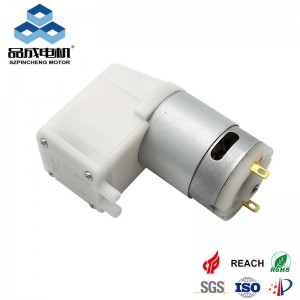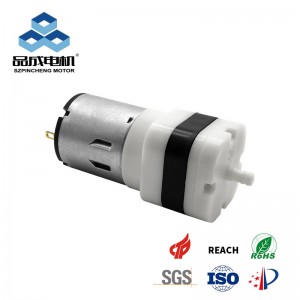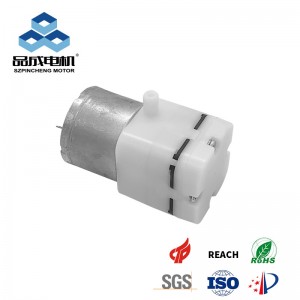Miniature diaphragm pumps are critical components in medical devices, industrial automation, and environmental systems, requiring precise fluid control, durability, and compact design. The integration of multi-material 3D printing has revolutionized their manufacturing, enabling unprecedented customization and performance optimization. This article explores a groundbreaking MIT-led case study on multi-material 3D printing for miniature diaphragm pumps, alongside the innovative contributions of PingCheng Motor, a leader in advanced micro-pump solutions.
1. MIT’s Foundry Software: Enabling Multi-Material Design Innovation
At the forefront of this revolution is MIT’s Foundry software, a pioneering tool for multi-material 3D printing design. Developed by MIT’s Computer Science and Artificial Intelligence Laboratory (CSAIL), Foundry allows engineers to assign material properties at the voxel level (3D pixels), enabling precise control over mechanical, thermal, and chemical characteristics within a single component4.
Key Features of Foundry
-
Material Gradient Control: Smooth transitions between rigid and flexible materials (e.g., TPU and PLA) eliminate stress concentrations in diaphragm pump components.
-
Performance-Driven Design: Algorithms optimize material distribution for goals like fatigue resistance (critical for pumps undergoing millions of cycles) and energy efficiency14.
-
Manufacturability Integration: Compatible with multi-material printers like MultiFab, Foundry bridges design and production, reducing prototyping time by 70%4.
In MIT’s case study, researchers used Foundry to design a diaphragm pump with:
-
Stainless steel-reinforced edges for structural integrity.
-
Flexible silicone-based membranes for enhanced sealing.
-
Thermally conductive polymer channels to dissipate heat during high-speed operation4.
2. Multi-Material Design Challenges and Solutions
Material Compatibility
Combining materials like PEEK (for chemical resistance) and carbon fiber-reinforced polymers (for strength) requires careful thermal and mechanical alignment. MIT’s data-driven approach, using Bayesian optimization, identified 12 optimal material formulations in just 30 experimental iterations, expanding the performance space by 288×1.
Structural Optimization
-
Topology Optimization: Algorithms remove low-stress material, reducing pump weight by 25% while maintaining pressure resistance (-85 kPa)47.
-
Anti-Warpage Techniques: For high-temperature materials like PEEK, MIT’s research showed that a nozzle temperature of 400°C and 60% infill rate minimized deformation7.
Case Study: PinCheng Motor’s Application
PingCheng Motor has leveraged multi-material 3D printing to develop its 385 Micro Vacuum Pump, a compact solution for industrial packaging. Key innovations include:
-
Dual-Material Diaphragm: A hybrid of FKM fluoropolymer (chemical resistance) and carbon-fiber-reinforced PEEK (high strength), achieving 15,000+ hours of maintenance-free operation7.
-
IoT-Enabled Design: Embedded sensors monitor pressure and temperature in real time, enabling predictive maintenance through AI algorithms4.
3. Advantages of Multi-Material 3D Printing in Pump Manufacturing
| Benefit | Impact | Example |
|---|---|---|
| Weight Reduction | 30–40% lighter pumps | Aerospace-grade titanium-PEEK composites7 |
| Enhanced Durability | 2× lifespan vs. single-material pumps | MIT’s stainless steel-silicone hybrid diaphragm4 |
| Customization | Application-specific material gradients | Medical pumps with biocompatible outer layers and rigid internal supports1 |
4. Future Directions and Industry Impact
-
AI-Driven Material Discovery: MIT’s machine learning framework accelerates the identification of novel polymer blends, targeting applications like corrosion-resistant pumps for chemical processing1.
-
Sustainable Manufacturing: PinCheng Motor is exploring recyclable thermoplastics and decentralized production networks to reduce waste, inspired by projects like the University College London’s “Metaplas” system10.
-
Smart Pumps: Integration of thermochromic materials (for temperature-responsive fluid control) and self-healing polymers10.
Conclusion
The fusion of MIT’s Foundry software and PinCheng Motor’s engineering expertise exemplifies the transformative potential of multi-material 3D printing in miniature diaphragm pump manufacturing. By optimizing material combinations and embracing AI-driven design, this technology addresses critical challenges in durability, efficiency, and customization.
Explore PinCheng Motor’s innovative pump solutions:
Visit PingCheng Motor’s official website to discover cutting-edge products like the 385 Micro Vacuum Pump and customized OEM/ODM services.
you like also all
Post time: Apr-26-2025




